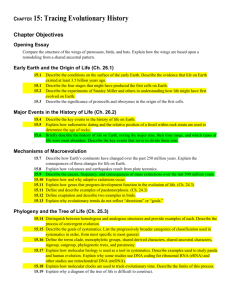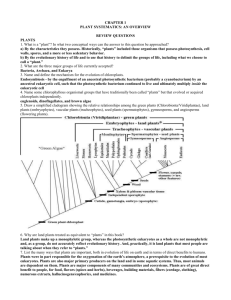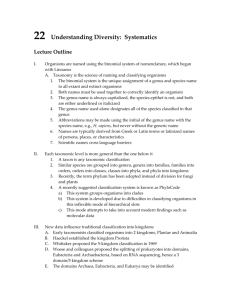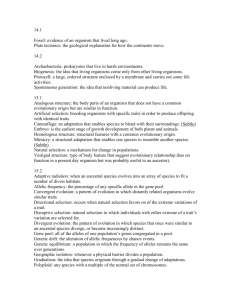Systematic & Speciation
advertisement
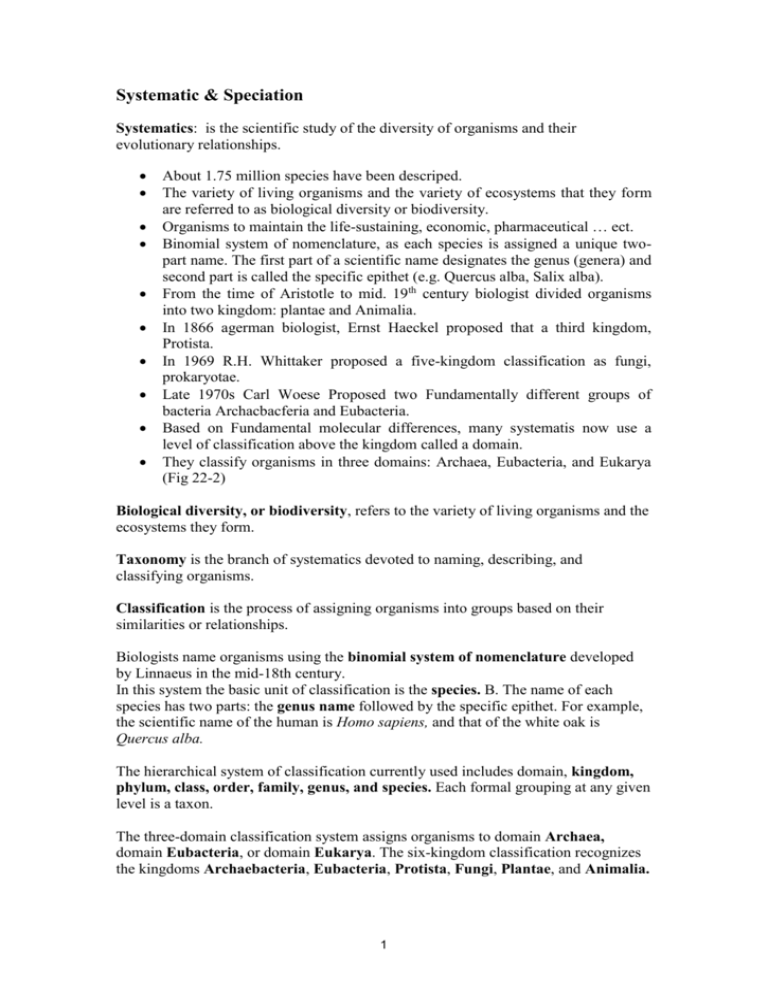
Systematic & Speciation Systematics: is the scientific study of the diversity of organisms and their evolutionary relationships. About 1.75 million species have been descriped. The variety of living organisms and the variety of ecosystems that they form are referred to as biological diversity or biodiversity. Organisms to maintain the life-sustaining, economic, pharmaceutical … ect. Binomial system of nomenclature, as each species is assigned a unique twopart name. The first part of a scientific name designates the genus (genera) and second part is called the specific epithet (e.g. Quercus alba, Salix alba). From the time of Aristotle to mid. 19th century biologist divided organisms into two kingdom: plantae and Animalia. In 1866 agerman biologist, Ernst Haeckel proposed that a third kingdom, Protista. In 1969 R.H. Whittaker proposed a five-kingdom classification as fungi, prokaryotae. Late 1970s Carl Woese Proposed two Fundamentally different groups of bacteria Archacbacferia and Eubacteria. Based on Fundamental molecular differences, many systematis now use a level of classification above the kingdom called a domain. They classify organisms in three domains: Archaea, Eubacteria, and Eukarya (Fig 22-2) Biological diversity, or biodiversity, refers to the variety of living organisms and the ecosystems they form. Taxonomy is the branch of systematics devoted to naming, describing, and classifying organisms. Classification is the process of assigning organisms into groups based on their similarities or relationships. Biologists name organisms using the binomial system of nomenclature developed by Linnaeus in the mid-18th century. In this system the basic unit of classification is the species. B. The name of each species has two parts: the genus name followed by the specific epithet. For example, the scientific name of the human is Homo sapiens, and that of the white oak is Quercus alba. The hierarchical system of classification currently used includes domain, kingdom, phylum, class, order, family, genus, and species. Each formal grouping at any given level is a taxon. The three-domain classification system assigns organisms to domain Archaea, domain Eubacteria, or domain Eukarya. The six-kingdom classification recognizes the kingdoms Archaebacteria, Eubacteria, Protista, Fungi, Plantae, and Animalia. 1 The goal of systematics is to determine evolutionary relationships, or phylogeny, based on shared characteristics. Homology implies evolution from a common ancestor. Homoplasy refers to superficially similar characters that are not homologous because they evolved independently. Shared ancestral characters, or plesiomorphic characters, suggest a distant common ancestor. Shared derived characters, or synapomorphic characters, indicate a more recent common ancestor. Molecular systematics provides methods for comparing macromolecules such as nucleic acids and proteins for assessing evolutionary relationships. Comparison of nucleotide sequences in ribosomal RNA has led to important taxonomic decisions regarding domains, kingdoms, and species. A monophyletic group includes all of the descendants of the most recent common ancestor. A paraphyletic group consists of a common ancestor and some, but not all, of its descendents. The organisms in a polyphyletic group evolved from different ancestors. Three approaches to systematics are: 1) Phenetics, 2) Evolutionary 3) Phylogenetic systematics, also known as cladistics. 1. Phenetics, or numerical taxonomy, is characters; this was an early approach in which organisms were classified according to the number of characteristics they shared without trying to determine whether their similarities were homologous or homoplastic. 2. Evolutionary systematics considers both evolutionary branching and the extent of divergence. Evolutionary systematics is based on shared ancestral characters as well as shared derived characters. 3. Cladistics, also called phylogenetic systematics, insists that taxa be monophyletic. Each monophyletic taxon, or clad consists of a common ancestor and all its descendents. Shared derived characters are used to determine these relationships. Diagrams called cladograms are used to illustrate phylogeny. A- Cladists use outgroup analysis to determine which characters are ancestral and which are derived in a given group of taxa. An outgroup is a taxon that represents the ancestral condition because it diverged earlier than any of the other taxa being investigated. B. Cladists use the principle of parsimony: They choose the simplest explanation to interpret the data. 2 C. In interpreting cladograms, the relationships among taxa can only be determined by tracing along the branches back to the most recent common ancestor (represented by a node on the cladogram) D. The cladogram indicates which taxa shared a common ancestor and how recently they shared that ancestor. 3



